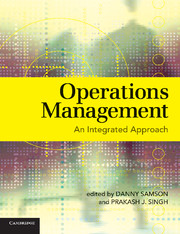Book contents
- Frontmatter
- Contents
- List of Contributors
- Preface
- Acknowledgements
- Part I Operations within Organisations – Building Blocks
- 1 What is Operations Management and Why is it Important?
- 2 Operating System Models
- 3 Key Decisions in OM
- 4 Planning and Controlling the Use of Operating Assets and Resources
- Part II Approaches to Understanding OM
- Part III Moving Forward with OM – Creating Competitive Advantage
- Part IV Challenges and Opportunities in Operations
- Part V Case Studies
- Index
- References
4 - Planning and Controlling the Use of Operating Assets and Resources
Published online by Cambridge University Press: 05 June 2012
- Frontmatter
- Contents
- List of Contributors
- Preface
- Acknowledgements
- Part I Operations within Organisations – Building Blocks
- 1 What is Operations Management and Why is it Important?
- 2 Operating System Models
- 3 Key Decisions in OM
- 4 Planning and Controlling the Use of Operating Assets and Resources
- Part II Approaches to Understanding OM
- Part III Moving Forward with OM – Creating Competitive Advantage
- Part IV Challenges and Opportunities in Operations
- Part V Case Studies
- Index
- References
Summary
Learning objectives
After reading this chapter you should be able to:
understand the hierarchy of planning decisions that are involved in operations management
understand the role of inventory and basic inventory management systems
appreciate the need for the aggregation and disaggregation of operating plans
be familiar with the different strategies for aggregate planning
understand the process of developing a master schedule and materials plan
know the workings of a material requirements planning (MRP) system and critical success factors for its implementation.
Box 4.1: Management challenge: managing quotations to customers
Sayon Nara Systems is an authorised distributor for electrical and electronics components and systems. It has 45 employees working in five sales offices in Asia – China, Indonesia, Singapore, the Philippines, and Vietnam. The company's headquarter is located in Thailand. It has an office space of more than 700 square metres inclusive of a warehouse to stock more than US$220 000 worth of products.
The company carries fifty product types and is also involved in the trading of semiconductor components. The product range includes electronic capacitors, connectors, and hardware for entire systems. Besides standard products, Sayon Nara also customises products to meet specific customer needs.
Different products have different sizes and weights. The company has to mark up on the cost prices to cover the freight, delivery and administrative costs and profits. With so many factors that have to be taken into consideration in costings, the mark-ups vary considerably across customers. […]
- Type
- Chapter
- Information
- Operations ManagementAn Integrated Approach, pp. 90 - 120Publisher: Cambridge University PressPrint publication year: 2008



